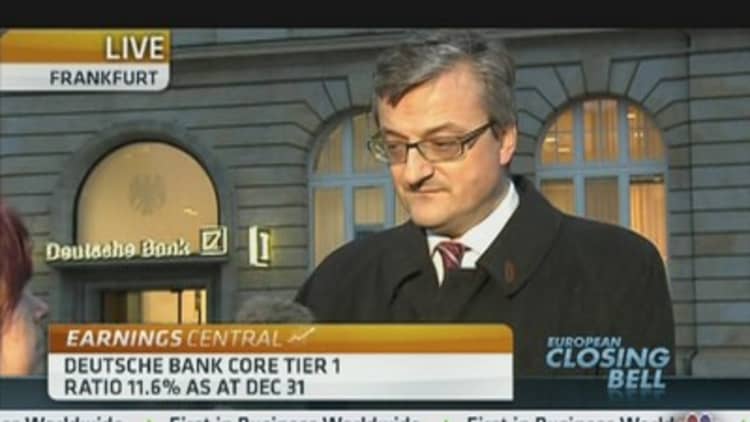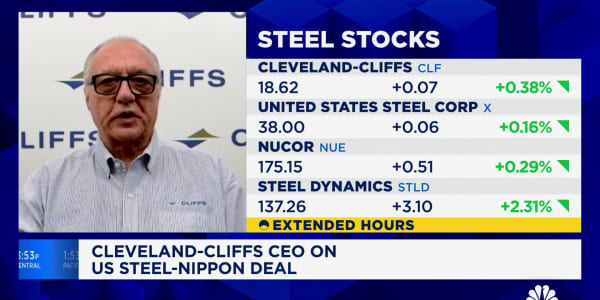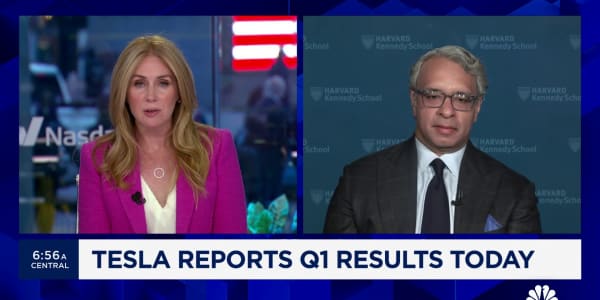In the go-go years before the financial crisis, banks were regularly rewarded for aggressively playing with their numbers. Banks that could show rising returns on equity saw their share prices soar. Banks that played it safer saw shares fall. Naturally, this pushed banks to become ever more aggressive about the way they accounted for their assets.
One of the nice things about the financial crisis was that investors started punishing companies that seemed to play games with their numbers. Think of all the heat David Einhorn was able to bring to bear on Lehman Brothers and chief financial office Erin Callan. This encouraged nearly everyone to 'fess up to losses.
Now it seems we're back to the bad old days.
On Thursday, Deutsche Bank announced that it had boosted its capital ratio—and immediately saw its stock soar.
What made the capital ratio boost so unusual, however, was that Deutsche Bank didn't do very much by way of the the real world things banks can do to boost their capital ratio.

The number one thing a bank can do to boost capital is make money and retain the earnings. Which is to say, the bank can actually build up its capital reserves. But Deutsche Bank lost $3.5 billion in the quarter—so it wasn't accumulated and retained earnings that provided capital.
Banks can also grow their capital ratios by selling equity. Deutsche Bank didn't do this either.
Another way of increasing your capital ratio is by attacking the other side of the ratio by reducing the assets a bank holds. All other things being equal, when banks have fewer loans on the books, the need to hold capital against losses shrinks. This is almost what Deutsche Bank did, although it achieved a sizable portion of this downsizing not by actually selling assets but by either changing the math or acquiring new assets.
Deutsche Bank says it achieved 55 euros billion of "de-risking" in the quarter. Here's how Reuters explained this:
Deutsche Bank cut its risk-weighted asset (RWA) base by 55 billion euros in the fourth quarter, helping to raise its core tier one capital ratio under Basel III rules to 8 percent at the end of 2012 from under 6 percent at the end of 2011.
RWAs are a bank's assets, usually loans, adjusted for the likelihood of non-payment.
So one of the big things Deutsche Bank did was adjust the way it calculates its RWAs. For some of the assets on its balance sheet, the bank just changed how it measures their risk. For other assets, the bank said it put in place hedges that it believes reduced risk.
It's impossible to know exactly how much of Deutsche Bank's capital ratio improvement came from hedging and changing the math that went into risk calculations. The bank says that 18 billion euros of the improvement came from "roll out of advanced models." Another 8 billion euros of improvement came from "data improvement exercises," using a new internal model for derivatives, and activation of some collateral. So mostly more changes to the math than the actual assets. As Matt Levine at DealBreaker puts it, the bank shed 26 billion euros of assets by "changing how the computers are programmed."
"Portfolio Optimization" accounts for another 15 billion euros. Some of this might have been the sale of actual assets. But included in this basket is "optimizing risk mitigation," which is to say the bank believes it has hedged these risks. What this means, in turn, is that the bank still holds the original assets but believes it has less risk of losing money on those assets because they purchased other assets that will make money if those go down in value.
In short, Deutsche Bank achieved a sizable but ultimately unknowable amount of this risk reduction—which the bank says is the equivalent of raising 8 billion euros of new capital—by clever mathematics. It modeled its way into a higher capital ratio.
This doesn't mean Deutsche Bank hasn't actually reduced its risk. It's hedges, for example, may be well-conceived and effective. Although it's impossible for an investor to know what those hedges are because Deutsche Bank doesn't say very much about them. So they might also be London Whale style hedges.
The adjustments to the models may be improvements as well. Perhaps Deutsche Bank really does understand its assets better and so it has formulated a better model for judging risk internally—one that just happened to contribute to an improvement in its capital ratio. Again, however, there's no way for investors to know whether this is the case because the bank doesn't provide any information about the changes to its models.
When it comes to deciding whether risk mitigation has been optimized, whether the models really have advanced, and the data has been improved—investors just have to trust Deutsche Bank. And, judging by the rise of the bank's stock, it appears many are willing to do just that.
This might not be entirely irrational, of course. Remember that the capital ratio is, first and foremost, a regulatory requirement. When Deutsche Bank says it has "de-risked" it's not necessarily talking about reducing real world risk. It is talking about regulatory risk. That is, it is saying that in the eyes of the regulators, risk has been reduced. Regulators are therefore unlikely to require the bank to actually sell off assets, halt dividends, or sell new equity.
Investors are now more concerned about regulatory compliance than actual liquidity or solvency. This could be looked at as a sign of strength in the banking system. Or complacency.
Follow me on Twitter @Carney






